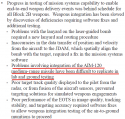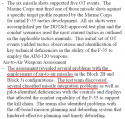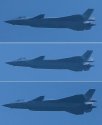Those aside I want to go back to my main theme. Weapons separation testing is a key milestone and is a demonstration of progress. I based my assessment of a program's progress on evidence and not ideological preference. The F-35's first AMRAAM testing was on 31st October 2012 followed by another on 15th November 2012. To-date, I have seen no direct evidence that weapon separation had been conducted at supersonic speed. However I have seen reports over the successive years that various problems were encountered. They include :
from 2013 DOT&E report of integration issues encountered during live testing not replicable in simulation.
View attachment 52958
These issues subsequently were known to be bay thermal issues under certain conditions and vibration issues above allowances
View attachment 52959
Source: AWST Jan 13, 2014
The problems continued through the different years as reported through the DOT&E. Even as late as 2017 DOT&E
View attachment 52960
Successful weapons separation is a sum of many moving parts. Since the first flight in December 2006 to 2017 is a span of eleven years. Only in the 2018 DOT&E there were no further mention of the problems. It may suggest that the problems were flying resolved.
I think it is incredibly naïve in the absence of any evidence to make bold assumptions concerning progress and ridicule others who have a different view. .
On the surface of it, your question seems fine, but for the purposes of PLA watching I think your question betrays two unreasonable assumptions.
First:
You are absolutely correct in saying that we should judge any program based on what milestones have been reached through its development.
However, asking for "proof" of evidence of milestones for Chinese weapons programs implies that it would be reasonable for us to expect to receive "proof" in the first place, whereas anyone familiar with PLA watching would be aware that such milestones in development are almost never released to the public.
In other words, the very fact that you ask for "proof" of milestones, suggests to me that you believe a lack of "proof" is an accurate reflection of what milestones may have actually been achieved. I think this is an incorrect assumption and not useful for the purposes of PLA watching.
Second:
The second unreasonable assumption is slightly more technical and is related to what milestones one can reasonably expect to have been achieved by the time other milestones are met.
For example, it is reported from the PLA that that J-20 first entered service about 2 years ago which we deduced was in a capacity for training/doctrine capacity, and last year (
) was announced to have been commissioned in a combat capable capacity.
With those milestones having been met, we will have to ask ourselves what other milestones would likely have to had been met prior to being accepted into service and being accepted into combat capable service, considering what know about tests for other similar aircraft?
Yet, the fact that you ask your question means that your assumption may believe in one of the two domains (or both):
1: the PLA's statement about J-20s being in combat service are "not credible" or "not equivalent" to perhaps what western air forces would consider to be in combat service and thus may not require the same milestones to have been met...
or/and
2: supersonic weapons testing is not a domain of testing that would be required to have been done before an aircraft could be declared in service for combat...
I do not believe either of those subdomains to be reasonable assumptions.
=======
And just for the record, we do have a record for when the F-35 conducted its first supersonic weapons release (late November 2014), from the official F-35 lockmart website even:
·Three Weapon(s) Delivery Accuracy (WDA) live fire events completed in a week. The F-35 employed two AIM-120 AMRAAMs and one Joint Direct Attack Munition (JDAM). These events included the first supersonic-guided missile launch and the first JDAM release on target coordinates generated from the Electro-Optical Targeting System (EOTS) (Nov. 18-25 )
This is two years between the first AMRAAM launch of an F-35 done in October 2012, and the first supersonic guided missile launch of an AMRAAM.
For the F-22, the first AMRAAM launch from an EMD prototype was done in October 2000, the first guided AMRAAM launch done in September 2001, and the first supersonic AMRAAM separation test done in August 2002 and the first supersonic guided AMRAAM launch in November 2002. About two years as well.
EDIT:
I will also add, that your posts about DOT&E reports regarding issues faced during trials, development and initial service are only relevant if anyone else has argued that J-20 had not faced hiccups during its trials, development and initial service as well. If you were to ask me that question I would say that it is obvious that J-20 has likely faced similar challenges during its development and early service (and may continue to do so at present) as well -- all new aircraft types go through similar teething issues.
However, those DOT&E reports are entirely irrelevant if you are think it's reasonable to believe that J-20 has yet to conduct supersonic missile launch tests let alone supersonic missile separation tests.






